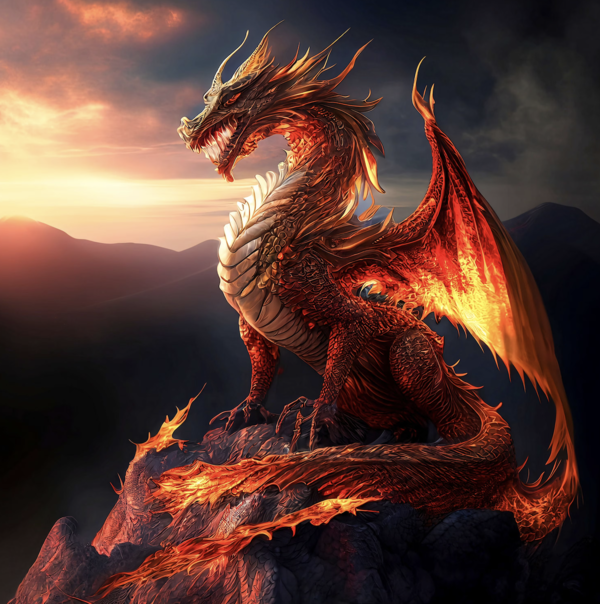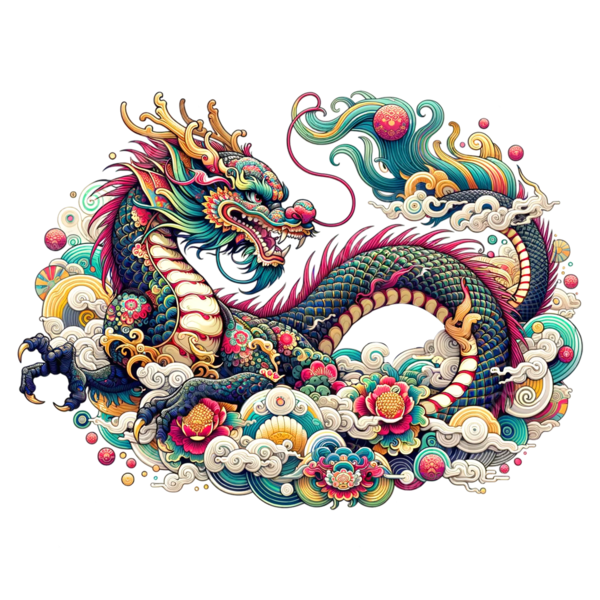As we step into 2024, we find ourselves under the powerful influence of the Wood Dragon. This majestic creature, steeped in myth and symbolism, invites us to explore its rich lore and the traits it embodies.
In Chinese culture, the dragon is not just a creature of fantasy; it is a symbol of strength, authority, and good fortune. Unlike the fearsome dragons of Western mythology, Chinese dragons are benevolent beings, often associated with water, rainfall, and fertility. They are believed to control rivers, lakes, and oceans, bringing life and sustenance to the earth.

In addition to being a Dragon year, 2024 is specifically the Year of the Wood Dragon. Each zodiac animal is paired with one of the five elements: Wood, Fire, Earth, Metal, and Water. The Wood element symbolizes growth, flexibility, and creativity. It encourages a focus on nurturing relationships and cultivating new ideas. The Wood Dragon, therefore, is a catalyst for positive change, urging individuals to pursue personal and professional growth.
People born in the Year of the Dragon are often seen as charismatic and natural leaders. Here are some key traits associated with the Wood Dragon:
Confidence: Wood Dragons possess a natural self-assurance that draws others in. They are unafraid to express their opinions and pursue their goals.
Creativity: With the influence of the Wood element, these Dragons are innovative thinkers, often coming up with unique solutions to challenges.
Passion: Wood Dragons approach life with enthusiasm. They are deeply invested in their pursuits and inspire those around them to share in their passions.
Empathy: Unlike other Dragon types, the Wood Dragon is more attuned to the emotions of others, fostering deeper connections and understanding.
Resilience: The combination of the Dragon's strength and the Wood element's adaptability makes these individuals particularly resilient in the face of challenges.
As we navigate through 2024, here are some ways to harness the positive energy of the Wood Dragon:
Set Ambitious Goals: This is a year for taking bold steps. Whether it’s a new job, a creative project, or a personal milestone, aim high and pursue your dreams.
Nurture Relationships: Take time to connect with friends, family, and colleagues. Foster collaboration and create networks that support mutual growth.
Embrace Change: The Wood Dragon thrives on transformation. Be open to new experiences and adaptable in the face of change.
Cultivate Creativity: Engage in activities that stimulate your creativity. Whether it’s painting, writing, or starting a new hobby, let your imagination run wild.
Practice Empathy: Take the time to listen and understand others. This will not only strengthen your relationships but also foster a supportive environment.
2024, the Year of the Wood Dragon, is a powerful time for growth, creativity, and connection. By embodying the traits of this majestic creature, we can navigate the year with confidence and purpose. Embrace the energy of the Wood Dragon, and let it guide you towards success, fulfillment, and harmonious relationships. As the dragon soars, so too can we, tapping into its strength to overcome obstacles and seize opportunities that lie ahead.

Dragons are some of the most iconic and fascinating creatures in mythology, often depicted as powerful beings that can fly and breathe fire. But have dragons ever really existed? In this article, we will explore the origins of dragons, the evidence that fuels their legends, and how these mythical creatures have captured our imagination throughout history.
The concept of dragons can be traced back to ancient civilizations across the globe. From Mesopotamia to China, various cultures have stories about large, serpentine creatures. These dragons often embodied the fears and hopes of the societies that created them.
Mesopotamian Dragons: The ancient Babylonians had a dragon-like creature called Tiamat, who represented chaos and was defeated by the god Marduk. This myth highlights the dragon as a symbol of chaos that must be conquered.
Chinese Dragons: In contrast, Chinese dragons are often viewed as benevolent creatures associated with water, fertility, and good fortune. They are celebrated in festivals and revered in folklore.
European Dragons: In European mythology, dragons are typically depicted as malevolent beings, hoarding treasure and challenging heroes. Stories like those of St. George slaying a dragon symbolize the triumph of good over evil.
The characteristics of dragons have evolved over time. Early depictions were often inspired by real animals, such as crocodiles and large snakes. As these myths spread, they blended with local cultures and beliefs, leading to the diverse representations of dragons we see today.
One possible explanation for the dragon myth is the discovery of large dinosaur fossils. Ancient people may have come across these remains and, without an understanding of paleontology, created stories around them. For example, large bones could have inspired tales of massive, fire-breathing beasts.
Additionally, the discovery of large predatory reptiles, such as the Tyrannosaurus rex or marine reptiles like Mosasaurus, may have contributed to dragon legends. These creatures were often depicted with characteristics that resemble those of dragons.
Many dragon myths may also be rooted in encounters with large snakes or crocodiles. These real-life animals can appear dragon-like, especially when seen from a distance. Their impressive size and sometimes aggressive behavior could easily fuel stories of fearsome creatures lurking in the water or jungles.
Dragons hold a special place in the hearts of many cultures, serving various symbolic purposes:
Guardianship: In many cultures, dragons are seen as guardians of treasure or sacred knowledge. They symbolize the protection of wealth and wisdom.
Chaos and Order: Dragons often represent chaos that must be tamed or defeated, illustrating the struggle between good and evil in human narratives.
Power and Strength: The imagery of dragons often conveys ideas of power, authority, and the potential for transformation, inspiring awe and respect.
While there is no concrete evidence that dragons, as they are portrayed in myths, ever existed, their origins can be traced back to a combination of ancient beliefs, real-life creatures, and cultural symbolism. Dragons continue to capture our imagination, representing a blend of fear, power, and wonder.
So, the next time you hear a story about dragons, remember that these mythical beings are a reflection of humanity's fascination with the unknown and the powerful forces of nature. Whether through ancient tales or modern fantasy, dragons will always hold a special place in our hearts and minds.

Dragons have captivated human imagination for centuries, appearing in mythologies, folklore, and modern media across the globe. From their awe-inspiring designs to their symbolic meanings, dragons are more than just mythical creatures; they represent various cultural beliefs and human aspirations. In this article, we will explore the origins of dragons, their significance in different cultures, and their enduring popularity in today's world.
Dragons are legendary creatures typically depicted as large, serpentine beings with the ability to fly and breathe fire. They can vary significantly in appearance and characteristics based on cultural context. While often associated with power and majesty, the portrayal of dragons can range from benevolent guardians to fearsome beasts.
Physical Features: Dragons are often depicted with scales, sharp claws, and powerful wings. Their size can vary, but they are usually portrayed as massive creatures.
Fire-Breathing: One of the most iconic traits of dragons is their ability to breathe fire. This ability symbolizes destruction but also power and transformation.
Intelligence: Many stories depict dragons as highly intelligent beings, often possessing ancient wisdom. They may engage in conversations or possess magical abilities.
Guardianship: In many myths, dragons serve as guardians of treasure or sacred spaces, symbolizing the protection of wealth and knowledge.
In Chinese culture, dragons are revered as auspicious and benevolent creatures. They symbolize strength, power, and good fortune. Unlike their Western counterparts, Chinese dragons are associated with water and rainfall, believed to bring prosperity and fertility to the land. The dragon dance is a popular celebration during festivals, symbolizing joy and luck.
European dragons are often depicted as malevolent creatures, hoarding treasures and wreaking havoc on villages. They are commonly found in medieval tales, where heroes embark on quests to slay these fearsome beasts. The image of the dragon in European folklore often represents chaos and evil, serving as an antagonist in many stories.
Japanese dragons are similar to Chinese dragons in their benevolence but are often associated with water and weather. They are depicted as protectors of rice fields and are revered in Shinto beliefs. In Japan, the dragon is a symbol of strength and resilience, often portrayed as a protector of the land.
Dragons have made a significant impact on modern literature, film, and video games. Their popularity has only grown, leading to a rich tapestry of dragon-related content.
Dragons are central figures in fantasy literature, with authors like J.R.R. Tolkien and George R.R. Martin bringing them to life in epic narratives. Books such as "The Hobbit" and "A Song of Ice and Fire" showcase dragons as powerful and complex characters, adding depth to their stories.
Movies and series often portray dragons in various roles, from heroic allies to terrifying adversaries. Iconic films like "How to Train Your Dragon" and "Game of Thrones" have brought dragons to the forefront of popular culture, enchanting audiences with their breathtaking visuals and intricate stories.
Dragons are prevalent in video games, serving as bosses, companions, or even playable characters. Titles like "The Elder Scrolls V: Skyrim" and "Dragon Age" allow players to interact with dragons in immersive ways, further fueling their popularity in gaming communities.
Dragons are powerful symbols that have transcended time and culture, capturing the hearts and imaginations of people worldwide. Whether viewed as benevolent guardians or fearsome beasts, these mythical creatures embody strength, wisdom, and the human spirit's desire for adventure. Their continued presence in literature, film, and games ensures that dragons will remain a beloved part of our cultural landscape for generations to come. Embrace the magic and mystery of dragons, and let their stories inspire your own adventures!
animal tags: Dragons
We created this article in conjunction with AI technology, then made sure it was fact-checked and edited by a Animals Top editor.